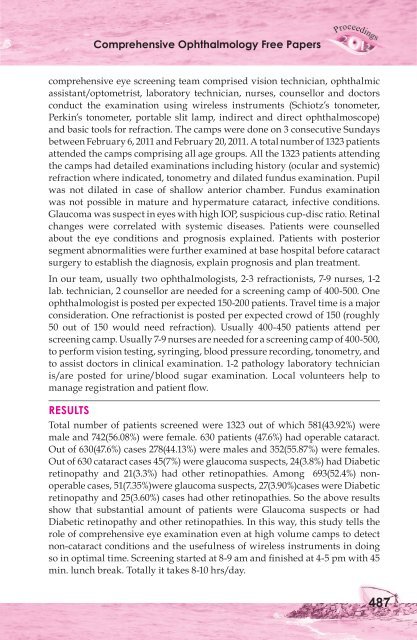Comprehensive Ophthalmology Free Papers - aioseducation
Comprehensive Ophthalmology Free Papers - aioseducation
Comprehensive Ophthalmology Free Papers - aioseducation
Create successful ePaper yourself
Turn your PDF publications into a flip-book with our unique Google optimized e-Paper software.
<strong>Comprehensive</strong> <strong>Ophthalmology</strong> <strong>Free</strong> <strong>Papers</strong><br />
comprehensive eye screening team comprised vision technician, ophthalmic<br />
assistant/optometrist, laboratory technician, nurses, counsellor and doctors<br />
conduct the examination using wireless instruments (Schiotz’s tonometer,<br />
Perkin’s tonometer, portable slit lamp, indirect and direct ophthalmoscope)<br />
and basic tools for refraction. The camps were done on 3 consecutive Sundays<br />
between February 6, 2011 and February 20, 2011. A total number of 1323 patients<br />
attended the camps comprising all age groups. All the 1323 patients attending<br />
the camps had detailed examinations including history (ocular and systemic)<br />
refraction where indicated, tonometry and dilated fundus examination. Pupil<br />
was not dilated in case of shallow anterior chamber. Fundus examination<br />
was not possible in mature and hypermature cataract, infective conditions.<br />
Glaucoma was suspect in eyes with high IOP, suspicious cup-disc ratio. Retinal<br />
changes were correlated with systemic diseases. Patients were counselled<br />
about the eye conditions and prognosis explained. Patients with posterior<br />
segment abnormalities were further examined at base hospital before cataract<br />
surgery to establish the diagnosis, explain prognosis and plan treatment.<br />
In our team, usually two ophthalmologists, 2-3 refractionists, 7-9 nurses, 1-2<br />
lab. technician, 2 counsellor are needed for a screening camp of 400-500. One<br />
ophthalmologist is posted per expected 150-200 patients. Travel time is a major<br />
consideration. One refractionist is posted per expected crowd of 150 (roughly<br />
50 out of 150 would need refraction). Usually 400-450 patients attend per<br />
screening camp. Usually 7-9 nurses are needed for a screening camp of 400-500,<br />
to perform vision testing, syringing, blood pressure recording, tonometry, and<br />
to assist doctors in clinical examination. 1-2 pathology laboratory technician<br />
is/are posted for urine/blood sugar examination. Local volunteers help to<br />
manage registration and patient flow.<br />
RESULTS<br />
Total number of patients screened were 1323 out of which 581(43.92%) were<br />
male and 742(56.08%) were female. 630 patients (47.6%) had operable cataract.<br />
Out of 630(47.6%) cases 278(44.13%) were males and 352(55.87%) were females.<br />
Out of 630 cataract cases 45(7%) were glaucoma suspects, 24(3.8%) had Diabetic<br />
retinopathy and 21(3.3%) had other retinopathies. Among 693(52.4%) nonoperable<br />
cases, 51(7.35%)were glaucoma suspects, 27(3.90%)cases were Diabetic<br />
retinopathy and 25(3.60%) cases had other retinopathies. So the above results<br />
show that substantial amount of patients were Glaucoma suspects or had<br />
Diabetic retinopathy and other retinopathies. In this way, this study tells the<br />
role of comprehensive eye examination even at high volume camps to detect<br />
non-cataract conditions and the usefulness of wireless instruments in doing<br />
so in optimal time. Screening started at 8-9 am and finished at 4-5 pm with 45<br />
min. lunch break. Totally it takes 8-10 hrs/day.<br />
487

















